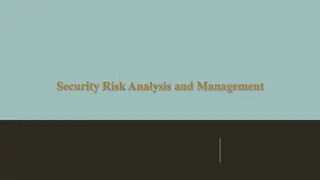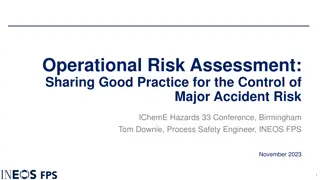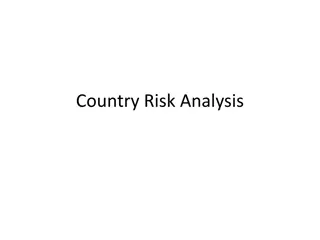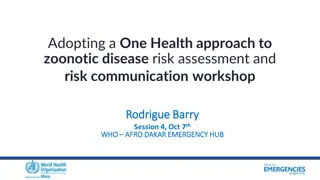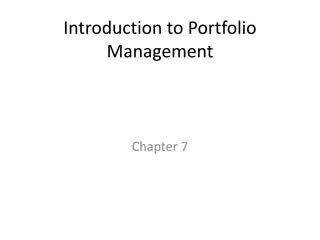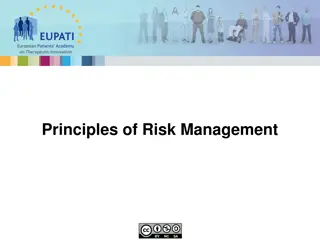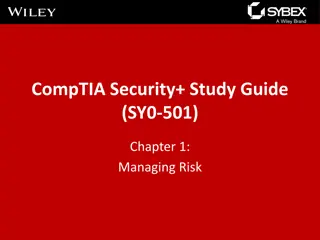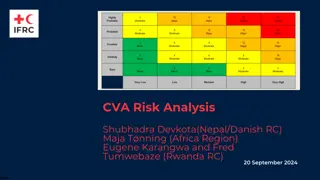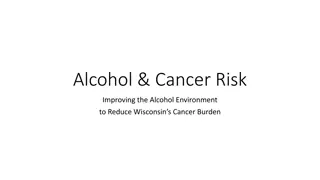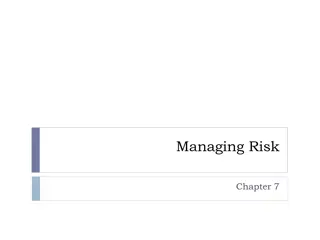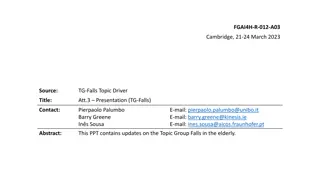
State Compensatory Education Programs for At-Risk Students
Learn about the AT-RISK-INDICATOR-CODE, eligibility criteria, and purpose of State Compensatory Education (SCE) programs in Texas for students at risk of dropping out of school. Discover who is considered at-risk and how the program aims to reduce performance disparities.
Uploaded on | 0 Views
Download Presentation

Please find below an Image/Link to download the presentation.
The content on the website is provided AS IS for your information and personal use only. It may not be sold, licensed, or shared on other websites without obtaining consent from the author. If you encounter any issues during the download, it is possible that the publisher has removed the file from their server.
You are allowed to download the files provided on this website for personal or commercial use, subject to the condition that they are used lawfully. All files are the property of their respective owners.
The content on the website is provided AS IS for your information and personal use only. It may not be sold, licensed, or shared on other websites without obtaining consent from the author.
E N D
Presentation Transcript
At Risk TSDS Fall Submission and beyond
What is it? AT-RISK-INDICATOR-CODE (E0919) indicates whether a student is currently identified as at-risk of not meeting standards or dropping out of school using state-defined criteria (TEC 29.081, Compensatory and Accelerated Instruction). Local criteria are not included in this indicator code.
Purpose The purpose of state compensatory education (SCE) is to supplement the basic or regular education program with compensatory accelerated instruction in order to reduce any disparity in performance on assessment instruments administered under Subchapter B, Chapter 39 TEC, or disparity in the rates of high school completion between students at risk of dropping out of school and all other LEA students. The program requires Texas local education agencies (LEAs) to offer direct supplemental accelerated instruction to each student who meets one or more statutory or locally- defined eligibility ( at risk ) criteria. State Compensatory Education (SCE) program mandates and references can be found in the Texas Education Code (TEC) 29.081, 28.0217, 29.089 and 42.152. LEA s are required to serve each student who meets the statutory eligibility criteria regardless of whether the district receives funds underTEC 42.152.
Who is At-Risk? A student at-risk of dropping out of school includes each student who is under 26 years of age and who: 1. was not advanced from one grade level to the next for one or more school years; Skyward code: (Note: From 2010-2011 forward, TEC 29.081 (d-1) excludes from this criteria prekindergarten or kindergarten students who were not advanced to the next grade level as a result of a documented request by the student s parent.) This criteria never ends for the student. Once they meet this criteria, they are At Risk until they are 26.
Who is At-Risk? A student at-risk of dropping out of school includes each student who is under 26 years of age and who: 2. is in grade 7, 8, 9, 10, 11, or 12 and did not maintain an average equivalent to 70 on a scale of 100 in two or more subjects in the foundation curriculum during a semester in the preceding or current school year or is not maintaining such an average in two or more subjects in the foundation curriculum in the current semester; Skyward Code: High School and Middle School only
Who is At-Risk? A student at-risk of dropping out of school includes each student who is under 26 years of age and who: 3. did not perform satisfactorily on an assessment instrument administered to the student under TEC Subchapter B, Chapter 39, and who has not in the previous or current school year subsequently performed on that instrument or another appropriate instrument at a level equal to at least 110 percent of the level of satisfactory performance on that instrument Skyward Code: Accountability can provide assistance with this information.
Who is At-Risk? A student at-risk of dropping out of school includes each student who is under 26 years of age and who: 4. is in prekindergarten, kindergarten or grade 1, 2, or 3 and did not perform satisfactorily on a readiness test or assessment instrument administered during the current school year; Skyward Code: Elementary Only Accountability provides details for this criterion
Who is At-Risk? A student at-risk of dropping out of school includes each student who is under 26 years of age and who: 5. is pregnant or is a parent; Skyward Code:
Who is At-Risk? A student at-risk of dropping out of school includes each student who is under 26 years of age and who: 6. has been placed in an alternative education program in accordance with TEC 37.006 during the preceding or current school year; Skyward code:
Who is At-Risk? A student at-risk of dropping out of school includes each student who is under 26 years of age and who: 7. has been expelled in accordance with TEC 37.007 during the preceding or current school year; Skyward Code: This criteria is not applicable in Tarrant County as we have a JJAEP that we can send students to.
Who is At-Risk? A student at-risk of dropping out of school includes each student who is under 26 years of age and who: 8. is currently on parole, probation, deferred prosecution, or other conditional release; Skyward Code:
Who is At-Risk? A student at-risk of dropping out of school includes each student who is under 26 years of age and who: 9. was previously reported through the Public Education Information Management System (PEIMS) to have dropped out of school; NOTE: This could include by other school districts. Skyward Code: Middle School and High School only
Who is At-Risk? A student at-risk of dropping out of school includes each student who is under 26 years of age and who: 10. is a student of limited English proficiency, as defined by TEC 29.052; Skyward Code:
Who is At-Risk? A student at-risk of dropping out of school includes each student who is under 26 years of age and who: 11. is in the custody or care of the Department of Protective and Regulatory Services or has, during the current school year, been referred to the department by a school official, officer of the juvenile court, or law enforcement official; NOTE: Includes Foster Care Students Skyward Code:
Who is At-Risk? A student at-risk of dropping out of school includes each student who is under 26 years of age and who: 12. is homeless, as defined 42 U.S.C. Section 11434 (a), and its subsequent amendments. Skyward Code:
Who is At-Risk? Homeless--- U.S.C. 42 section 11434a https://codes.findlaw.com/us/title-42-the-public-health-and-welfare/42-usc-sect-11434a.html For purposes of this part: (1) The terms enroll and enrollment include attending classes and participating fully in school activities. (2) The term homeless children and youths -- (A) means individuals who lack a fixed, regular, and adequate nighttime residence (within the meaning of section 11302(a)(1) of this title); and (B) includes-- (i) children and youths who are sharing the housing of other persons due to loss of housing, economic hardship, or a similar reason; are living in motels, hotels, trailer parks, or camping grounds due to the lack of alternative adequate accommodations; are living in emergency or transitional shelters; are abandoned in hospitals; or are awaiting foster care placement; (ii) children and youths who have a primary nighttime residence that is a public or private place not designed for or ordinarily used as a regular sleeping accommodation for human beings (within the meaning of section 11302(a)(2)(C) of this title); (iii) children and youths who are living in cars, parks, public spaces, abandoned buildings, substandard housing, bus or train stations, or similar settings; and (iv) migratory children (as such term is defined in section 6399 of Title 20 ) who qualify as homeless for the purposes of this part because the children are living in circumstances described in clauses (i) through (iii).
Who is At-Risk? A student at-risk of dropping out of school includes each student who is under 26 years of age and who: 13. resided in the preceding school year or resides in the current school year in a residential placement facility in the district, including a detention facility, substance abuse treatment facility, emergency shelter, psychiatric hospital, halfway house, or foster group home. New information from State Comp Ed received 3/2017 FAQ. Is the residential placement facility, including a detention facility, substance abuse treatment facility, emergency shelter, psychiatric hospital, halfway house, or foster group home that the student resided in required to be in the district boundaries? No, the location of a facility does not affect a student s at risk status. If a student resides or resided in one of the facilities listed above during the current or preceding school year, the student is at risk and that at risk status is valid for two years after the date of their release from the facility. Districts must have a report from a facility or note from a counselor or social worker on letterhead states the admission/release dates of the student.
Who is At-Risk? A student at-risk of dropping out of school includes each student who is under 26 years of age and who: 13. resided in the preceding school year or resides in the current school year in a residential placement facility In (or Out) of the district, including a detention facility, substance abuse treatment facility, emergency shelter, psychiatric hospital, halfway house, or foster group home. Skyward Code:
Who is At-Risk? A student at-risk of dropping out of school includes each student who is under 26 years of age and who: 14. has been incarcerated or has a parent or guardian who has been incarcerated, within the lifetime of the student, in a penal institution as defined by Section 1.07, Penal Code. Skyward Code:
Who is At-Risk? A student at-risk of dropping out of school includes each student who is under 26 years of age and who: Or, regardless of the student s age, each student who participates in an adult education program provided under a high school diploma and industry certification charter school program under Section 29.259
Where Do I Code it? Student Management Students Students Student Profile At-Risk
Where Do I Code it? Student Management Student Services At-Risk Entry By Student
How Do I Code it using the Student Profile? Select the student Check for an existing At-Risk record If No Record Exist, Click the ADD button to add a new identification detail meeting a criteria
How Do I Code it using the Student Profile? Correct the Entry Date to the appropriate date for the student meeting this criteria Select the Type (Criteria) that the student meets In some cases you need to also add Identification Details in the freeform comment information Examples: Testing dates and scores, DAEP placement year, Retention grade level Click Save
How Do I Code it using the Student Profile? Select the student Check for an existing At-Risk record If A Record Already Exists, Expand the record to review the Identification information Review the Entry and Dismissal Date(s) and Details of the Identification(s) Records without Dismissal dates will report the student as At-Risk for TSDS PEIMS Add, Edit or Dismiss Identifications as needed (do not delete records unless they are mistakes) No overlapping date on matching criteria When all identification records are showing as Dismissed, the student should no longer report as At-Risk
How Do I Code it using the At-Risk Module? Student Services At Risk Entry by Student Set the Views to At-Risk Criteria
How Do I Code it using the At-Risk Module? Select the student Check for an existing At-Risk record (Student will have a Date Identified listed in the browse.) If the Student does not already have a Date Identified , then no At Risk record Exist Expand the record to review the Identification information Click Add Identification Detail Fill in the Entry Date, Type and Details Click Save
How Do I Code it using the At-Risk Module? Select the student Check for an existing At-Risk record (Student will have a Date Identified listed in the browse.) If A Record Already Exists, Expand the record to review the Identification information Review the Entry and Dismissal Date(s) and Details of the Identification(s) Records without Dismissal dates will report the student as At-Risk for TSDS PEIMS Add, Edit or Dismiss Identifications as needed (do not delete records unless they are mistakes) No overlapping date on matching criteria When all identification records are showing as Dismissed, the student should no longer report as At-Risk
How Do I Dismiss a Student? Select the student Expand the record to review the Identification information Review the Entry and Dismissal Date(s) and Details of the Identification(s) Records without Dismissal dates will report the student as At-Risk for TSDS PEIMS If the student no longer meets the criteria, Edit the Identification record and input a dismissal date When all identification records are showing as Dismissed, the student should no longer report as At-Risk
Reports: PEIMS 40100 Federal/State Reporting Texas State Reporting Texas Student Data System (TSDS)
Reports: PEIMS 40100 Federal/State Reporting Texas State Reporting Texas Student Data System (TSDS) TSDS PEIMS Data Processing
Reports: PEIMS 40100 HELPFUL HINT! Run this report prior to your At Risk Review and after you believe you are finished. Check to make sure all students are correctly indicated.
Report At Risk Reports Student Services At Risk Reports See the How to for setting up these reports.

